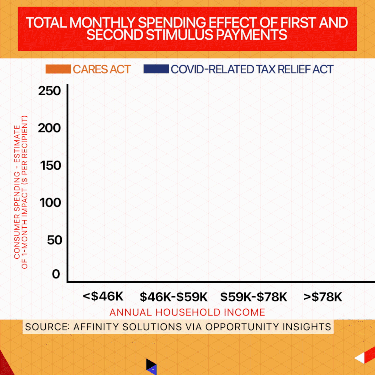
Call it a stimulus check. Call it a “survival check.” Or go on TikTok and call it a “stimmy.”
By any name, Americans are embracing the prospect of another $1,400 direct payment from Uncle Sam — and its popularity is a lesson in the politics of inclusion.
A recent Quinnipiac Poll found that 78 percent of Americans support a third round of stimulus checks. It ranks higher than raising the minimum wage (61 percent approve) or President Biden’s complete $1.9 trillion package (68 percent in favor). And Democrats believe one of the reasons the payments poll so well is because they took a page from Oprah’s playbook:
You get a check! You get a check! And you get a check!
The previous two checks were worth $1,200 and $600. And the rules to qualify for the full amount was simple: Anyone earning less than $75,000 a year got one. For couples, the bar was twice that amount, or $150,000 a year.
The high income threshold meant a lot of people were covered. The IRS reported 160 million received the first payment and 147 million got the second one. And Democrats were determined to preserve those parameters this time around as well.
“I call them survival checks because it is the most flexible funding we can send.” said Rep. Judy Chu (D-Calif.) during debate over the payments in the House Ways and Means committee.
That broad eligibility allows Democrats to frame the checks as a benefit for almost everybody — not just a government handout for the few. Too often, California Democratic Rep. Ro Khanna said, that can turn into a euphemism for low-income communities of color. And while the “stimmy” may be getting plenty of love on TikTok now, Khanna warned public sentiment can quickly devolve into racial stereotypes surrounding the welfare system of the past.
“Social Security is one of the most popular government programs ever because every person, regardless of race or class, knows someone who benefits from it,” Khanna said. “Likewise, pandemic survival checks will maintain broad, enduring support if we ensure that a wide socioeconomic cross-section of society benefits from them as well.”
Former President Trump also appeared to understand the appeal of the checks to his white working-class base as well. He was the one who forced Republicans to include the checks in the last COVID relief package, frustrating his own party. Georgia’s two GOP senators had to backtrack on their opposition to the payments, and the party’s early fumble may have cost them their seats. Democrats ousted the incumbent senators in January’s runoff elections after turning the stimulus checks into a campaign promise.
“The people of Georgia are the ones who helped to make this robust relief possible, a real sense they stood up not only for that state but for the country,” newly minted Sen. Raphael Warnock said. “And now it’s up to the Congress to deliver.”
But the economics do not mirror the politics. A growing amount of data suggests that a lot of the money from the stimulus checks went to households that didn’t immediately spend it.
To be sure, it’s clear the checks were a lifeline for millions of families struggling to make ends meet. Surveys by the Federal Reserve Bank of Philadelphia found that the first round of checks was most often used to pay for essentials. Through the summer, more than 42 percent of people said they spent their check on things like groceries and health care supplies. But saving the money ranked a close second or third.
The numbers are even more dramatic broken down by income. An analysis by a trio of economists from Brown and Harvard University found that households earning more than $78,000 only spent $45 of the $600 stimulus checks passed at the end of last year.

As for the potential third round of $1,400 checks? The nonpartisan Penn Wharton Budget Model projects roughly three-quarters would go straight into savings. And in fact, even the top 10 percent of households could still get thousands of dollars in benefits under Biden’s relief plan, both from the stimulus checks and an expansion of a popular tax credit for children.
Their data shows 73 percent of the next round of checks would go into savings and do little to boost economic growth.
“The money that we’re talking about in terms of stimulus payments is not targeted towards people that are actually hurt substantially by the permanent recession,” said Efraim Berkovich, who helped conduct the analysis.
Democrats have tried to address this through some last-minute changes to the relief package. Previously, the checks slowly got smaller for households with higher incomes, until they phased out altogether. Now, they disappear more quickly. Individuals earning more than $80,000 a year and couples making more than $160,000 a year won’t get a check at all — of any size. Experts project between 6 and 9 million people could be affected.
But Democrats refused to budge on who would receive the full $1,400. That remains the same: Anyone earning less than $75,000, or couples making less than $150,000. The Tax Foundation estimates almost 90 percent of tax filers will still get a check in the mail.
“When people want checks to help them get out of the morass, that’s not a liberal wish list—that’s what the American people want,” Senate Majority Leader Chuck Schumer said recently. “It’s an American wish list.”
And the political reality is, no one wants to be left out.



